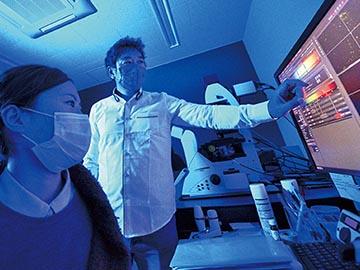TSUKUBA FRONTIER
#035 Searching for the Sleep/Wake Switch: And Studying the Biological Functions Supported by Sleep
Professor SAKURAI Takeshi, Faculty of Medicine & International Institute for Integrative Sleep Medicine

Sleep is integral to human life, but as anyone who has become drowsy at the worst possible time during daytime activity or been unable to sleep at night can attest, it often seems impervious to human control. Sleep and waking control is a function of the brain, however it turns out there is not one "sleep/wake" switch but a whole network of neural circuitry for this task. Today, we are on the brink of understanding the whole mechanism.
A New Peptide that Stabilizes Wakefulness

The identification of the new peptide* orexin in 1998 opened the door to new research into sleep. Orexin was discovered as part of an exhaustive study into the unknown substances in the brain. Initially, its function was a mystery; laboratory mice seemed to eat a lot under its influence, so initially orexin was thought to have something to do with appetite and feeding, but in fact, the new peptide functioned to stabilize wakefulness. As for appetite, there is a link: you can only eat when you're awake and hunger tends to wake you up—hence the mice's behavior.
The identification of orexin's function drew attention from researchers around the world and sparked a burst of momentum in sleep and wakefulness research. We are gradually discovering where signals by neurons that produce orexin are sent to, and where orexin-producing neurons receive signals from, and it turns out that there is a network of neural circuitry throughout the brain working as a switch to control sleep and wakefulness. That is, there is not one sleep/wake switch, but an entire process that significantly changes the "operating mode" of the brain itself. Once all the pieces of the puzzle are in place, it should reveal the whole mechanism of that switch.
* A peptide is a short chain of amino acids linked by peptide bonds.
The Role of Sleep
Our brains continue to work when we are asleep, but in a different way to when we are awake. Despite what you may have heard, REM and non-REM do not refer to the depth of sleep itself; the depth (or otherwise) of your sleep comes within the non-REM sleep phase. You cannot enter a deep sleep if the various parts of the "patchwork" of your brain are doing their own thing as you slumber; deep sleep happens when the many parts of the brain are in a uniform sleep state.
We are unconscious when we are asleep, and our brains also lose some of their functionality, but they still work during non-REM sleep to file away vast amounts of information learned when we are awake, and discard anything unnecessary. In other words, no matter how hard we study something, no matter how hard we practice a sport or a piece of music, our brains cannot retain that new knowledge or skill without proper sleep.
Science has yet to explain why animals need sleep, or to completely map the fundamental roles of sleep, REM sleep in particular. During REM sleep, the body's muscles are relaxed but the brain remains active, which means there must be a mechanism that paralyzes and prevents the body from moving along with the brain's activity. In recent years, we have learned that dual sleep patterns, REM and non-REM, occur not only in mammals but also in lower life forms. But why are there two sleep patterns? The solution to that puzzle will likely unlock treatments for sleep disorders.
Sleep and the Internal Body Clock
Your body's sleep/wake switch is closely related to your internal body clock. An internal body clock works to a rhythm of around 24 hours, but the timing gets "reset" every sunrise--that is, when your body is exposed to sunlight. The body clock can misjudge the time and that rhythm can be pushed backwards, though, if you stay up at night in a bright environment, for instance staying up excessively late under lights or continuing to look at your cell phone after you've gone to bed. On average, the sleep/wake switch is flicked to "sleep" and the body begins readying itself for sleep around 16 hours after first bathing in morning sunlight, but that transition might be interrupted if your internal body clock has been pushed out of time, making it hard to fall asleep. If you've ever decided to have an early night before an early start but couldn't get to sleep, that's why: your body hasn't switched from "wake" to "sleep" yet.
Things like lights at night and long-distance air travel are ubiquitous in modern life, but humanity has not yet evolved to meet such lifestyle developments, and we rely on workarounds such as sleeping pills when we can't get enough sleep.
Understanding the Workings of the Brain
The role of relaying information inside the brain is performed by synapses, and knowing how each synapse behaves is vital for learning about the workings of the brain. Synapses are not a fixed structure, but appear and disappear as needed, their forms and functions are constantly changing, meaning that on a microstructural level, your brain today is actually a different brain than yesterday.
It is possible to observe synapses using a two-photon microscope. The development of the two-photon microscope a decade or so ago made it possible to do things like see individual synapses inside the brains of live laboratory mice. Observing specific synapses before and after various activities revealed that the post-activity synapses were in a completely different state than pre-activity. We also now know that sleep has a significant effect on the synaptic structure of the cerebral cortex.
These microscopes, analytical devices, and technologies for manipulating nerve cells and modifying genes are vital for pursuing new research progress. Prof. Sakurai and his team are focusing on making effective use of the latest technologies to study the workings of the brain at the synaptic level during sleep.
The Future of Sleep Research
Recently, the institute's research has expanded from sleep and wakefulness to include hibernation. Sleep patterns in hibernation differ from animal to animal, but uninterrupted sleep for months on end is, in fact, rare; most hibernators have a repeating cycle of sleeping for a few days, waking for a while, then sleeping again. The hibernating animal has to wake from time to time to maintain nutrition and immunity, there is indeed some relation. Hibernation is completely different from regular sleep, but there might be some relationships between the two conditions.
In laboratory mice, Prof. Sakurai's team has discovered a neural circuit that induces a state of hibernation by regulating body temperature and metabolism. This raises the possibility of artificially controlling the duration of hibernation and, by extension, the potential for human hibernation. The prospect of hibernation for people is not entirely fanciful. For instance, there are plans for a migration to Mars in the 2030s, and artificially induced hibernation would be necessary for such an undertaking. Hibernating would be vital for keeping the need for food, oxygen, and life-support systems to a minimum, and could even help avoid the onset of mental problems caused by isolation in space. There are many issues to be resolved, such as how to wake someone from hibernation, but Prof. Sakurai believes human hibernation will become a reality.
Because neuroscience often focuses on the dynamic movements of the body, comparatively static phenomena like sleep previously struggled to attract attention as a subject for research. But the brain continues working in a variety of ways during sleep, and these have a strong correlation with behavior when awake. The discovery of the sleep/wake switch is not the end of sleep research, but the start of much, much more.
(SAKURAI / HIRANO Lab., International Institute for Integrative Sleep Medicine (WPI-IIIS), University of Tsukuba: https://sakurai-lab.com/english/)

Article by Science Communicator at the Office of Public Relations


